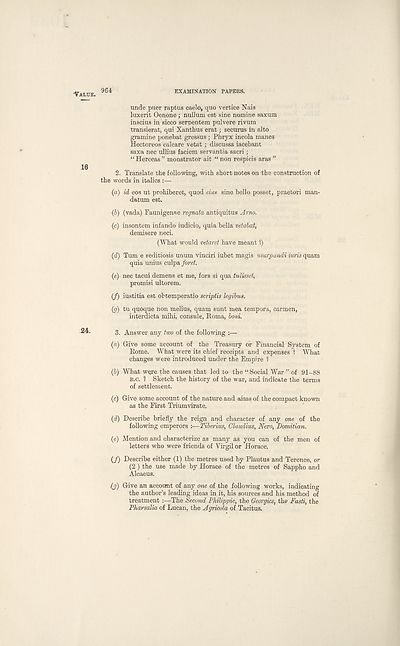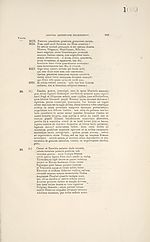Download files
Complete book:
Individual page:
Thumbnail gallery: Grid view | List view

964
EXAMINATION PAPERS.
unde puer raptus caelo, quo vertice Nais
luxerit Oenone; nullum est sine nomine saxum
inscius in sicco sernentem pulvere rivum
transierat, qui Xanthus erat; securus in alto
gramine ponebat gressus ; Phryx incola manes
Hectoreos calcare vetat ; discussa iacebant
saxa nee ullius faciem servantia sacri;
“Herceas ” monstrator ait “ non respicis aras ”
2. Translate the following, with short notes on the construction of
the words in italics :—
(а) id eos ut prohiberet, quod eius sine bello posset, praetori man-
datum est.
(б) (vada) Faunigenae regnata antiquitus Arno.
(c) insontem infando iudicio, quia bella vetabat,
demisere neci.
(What would vetaret have meant V)
(d) Turn e seditiosis unum vinciri iubet magis usurpandi iuris quam
quia unius culpa ford.
(e) nec tacui demens et me, fors si qua tulisset,
promisi ultorem.
(f) iustitia est obtemperatio scriptis legibus.
(g) tu quoque non melius, quam sunt mea tempora, carmen,
interdicta mihi, console, Roma, boni.
3. Answer any two of the following :—
(a) Give some account of the Treasury or Financial System of
Rome. What were its chief receipts and expenses ? What
changes were introduced under the Empire ?
(1) What were the causes that led to the “Social War” of 91-88
B.c. 1 Sketch the history of the war, and indicate the terms
of settlement.
(c) Give some account of the nature and aims of the compact known
as the First Triumvirate.
(d) Describe briefly the reign and character of any (me of the
following emperors :—Tiberius, Claudius, Nero, Domitian.
(e) Mention and characterize as many as you can of the men of
letters who were friends of Virgil or Horace.
(/) Describe either (1) the metres used by Plautus and Terence, or
(2 ) the use made by Horace of the metres of Sappho and
Alcaeus.
(g) Give an account of any one of the following works, indicating
the author’s leading ideas in it, his sources and his method of
treatment :—The Second Philippic, the Georgies, the Fasti, the
Pharsalia of Lucan, the Agricola of Tacitus.
EXAMINATION PAPERS.
unde puer raptus caelo, quo vertice Nais
luxerit Oenone; nullum est sine nomine saxum
inscius in sicco sernentem pulvere rivum
transierat, qui Xanthus erat; securus in alto
gramine ponebat gressus ; Phryx incola manes
Hectoreos calcare vetat ; discussa iacebant
saxa nee ullius faciem servantia sacri;
“Herceas ” monstrator ait “ non respicis aras ”
2. Translate the following, with short notes on the construction of
the words in italics :—
(а) id eos ut prohiberet, quod eius sine bello posset, praetori man-
datum est.
(б) (vada) Faunigenae regnata antiquitus Arno.
(c) insontem infando iudicio, quia bella vetabat,
demisere neci.
(What would vetaret have meant V)
(d) Turn e seditiosis unum vinciri iubet magis usurpandi iuris quam
quia unius culpa ford.
(e) nec tacui demens et me, fors si qua tulisset,
promisi ultorem.
(f) iustitia est obtemperatio scriptis legibus.
(g) tu quoque non melius, quam sunt mea tempora, carmen,
interdicta mihi, console, Roma, boni.
3. Answer any two of the following :—
(a) Give some account of the Treasury or Financial System of
Rome. What were its chief receipts and expenses ? What
changes were introduced under the Empire ?
(1) What were the causes that led to the “Social War” of 91-88
B.c. 1 Sketch the history of the war, and indicate the terms
of settlement.
(c) Give some account of the nature and aims of the compact known
as the First Triumvirate.
(d) Describe briefly the reign and character of any (me of the
following emperors :—Tiberius, Claudius, Nero, Domitian.
(e) Mention and characterize as many as you can of the men of
letters who were friends of Virgil or Horace.
(/) Describe either (1) the metres used by Plautus and Terence, or
(2 ) the use made by Horace of the metres of Sappho and
Alcaeus.
(g) Give an account of any one of the following works, indicating
the author’s leading ideas in it, his sources and his method of
treatment :—The Second Philippic, the Georgies, the Fasti, the
Pharsalia of Lucan, the Agricola of Tacitus.
Set display mode to:
![]() Universal Viewer |
Universal Viewer | ![]() Mirador |
Large image | Transcription
Mirador |
Large image | Transcription
Images and transcriptions on this page, including medium image downloads, may be used under the Creative Commons Attribution 4.0 International Licence unless otherwise stated. ![]()
| Scottish school exams and circulars > Leaving Certificate Examination > (14) |
|---|
| Permanent URL | https://digital.nls.uk/144136180 |
|---|
| Shelfmark | P.P. 1906 XXX |
|---|---|
| Attribution and copyright: |
|
| Description | Examination papers for the School Leaving Certificate 1888-1961 and the Scottish Certificate of Education 1962-1963. Produced by the Scotch (later 'Scottish') Education Department, these exam papers show how education developed in Scotland over this period, with a growing choice of subjects. Comparing them with current exam papers, there are obvious differences in the content and standards of the questions, and also in the layout and use of language |
|---|---|
| Additional NLS resources: |
|



